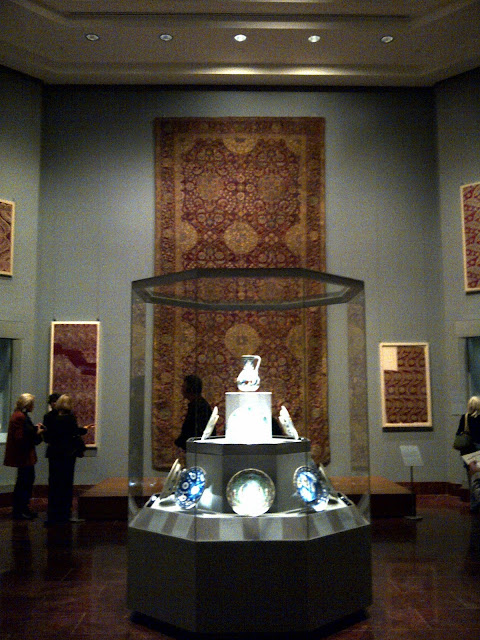After years of renovation, Metropolitan Muesum of Art opened the doors of their New Galleries for the art of the Arab lands, Turkey, Iran, Central Asia, and Later South Asia last week. The much anticipated Galleries of Islamic Art, which are an enchanting mix of the magnificent and the exotic seem to be an astounding success, if the crush in the galleries is any indication. Walking around the galleries is an experience akin to stepping through the pages of the Arabian Nights, with architectural elements and works of art encompassing 13 centuries and three continents, restrictions on western pictorial imagery turning every surface into reflections of eternal paradise, the expression of a culture representing the world in terms of an abstract, idealized nature.
Having been a student of Turkish decorative arts and illumination, I can always find plenty to be inspired by and to admire in these great works of art. The difference in this experience was the common link I found in some of works with my studies in Western art history. The lecture I attended given by Jerrilynn D. Dodds, Dean of Sarah Lawrence College, shed a whole new light on a subject I had always considered familiar.
Here are some of my favorites from the galleries as well as the works of art Professor Dodds talked about in her lecture that I found especially engaging:
Gallery 450
 |
Plate with Arabic Inscription
10th Century, Iran |
This elegant plate, according to Professor Dodds, might have hung on the wall of an Islamic household.
The inscription reads: "Planning before work protects you from regret; prosperity and peace."
The style of script, Kufi, developed in the city of Kufa, was the first and earliest form of calligraphy used in writing the Qur'an. Calligraphy is endowed with the most prominence in Islamic culture since the revelation of Islam was delivered word by word, letter by letter. Jerrilynn Dodds explained that according to Islam, the eternal can be known to the mind without being seduced by images. She also added that the elegant, abstract, design of calligraphy and it's undecipherable quality attested to a level of taste as well as a desire to be engaged intellectually.
Gallery 451
 |
| Ewer with a Feline-shaped Handle 7th Century, Iran |
This ewer was a particular favorite of mine. I really admired the pattern of undulating forms on the body of the vessel. It almost reminds me of some of Van Gogh's forms, if there wasn't such a uniformity.
Also the feline peeking into the ewer adds a charming touch.
Gallery 453
 |
| Bowl with central fish motif 13th Century, Iran, Kashan |
 |
| Rooster-headed Ewer 13th Century, Iran, Kashan |
 |
| Carved Star tile early 13th centruy, Iran |
Gallery 455
 |
| Tile from a squinch Second half 14th century, present day Uzbekistan, Samarqand |
Gallery 459
 |
| The Simonetti Carpet 1500, Egypt |
Galleries 459 and 460, The Koc family galleries, were cause for some pride since the family and the artifacts are both from Turkey. Unfortunately, it is almost impossible to take a photograph of the magnificent 16th century ceiling from Spain and do it justice.
 |
| 16th Century, Spain Originally from a church |
 |
 |
| Shaped Tiles in the 'Cuerda Seca' Techinque late 14th century, Konya, Turkey |
Gallery 461
This gallery is a reconstructed period room from the 18th century, Damascus, Syria.
 |
| Persian Garden Carpet, Second half 18th century, Iran |
Gallery 463
 |
| Nan va Halva (Breads and Sweets) Muhammad Baha' al-Din al-'Amidi, 1690, India |
There were some very interesting pieces with the influence of the West exhibited very clearly.
Gallery 464
There is so much to see and absorb that I am sure it will take me at least half a dozen trips to really feel satisfied with my efforts. The lecture by Jerylinn Dodds was so delightful, enlightening and relevant that it deserves a post of its own. Great things are better when taken in small doses anyway. Metropolitan Museum of Art's New Galleries should be on everyone's must-see list. I can't wait to go back.
 |
| Great Indian Fruitbat, circle of Bahawani Das, 1777-82, India, Calcutta |






Many thanks for this wonderful review Sedef. I love the intricacy and patterning in Islamic and Arab art.
ReplyDeleteIn Florence last year, I was surpised and delighted to find a section of the Barghello which included armour, textiles and artefacts from the Ottoman era, not far from the more often visited bronze David by Donatello.
Kind Regards and keep up the great work
H
This comment has been removed by the author.
ReplyDeleteThank you H. I am working on a more detailed post to follow up this one that I think you might find interesting. I plan to post it later today.
ReplyDeleteThrough this last experience I finally found a connection that is so much more than just the lovely intricate patterns. I hope you will check it out. I would love to get feedback from a Renaissance scholar on these concepts.
I appreciate your continued support,
S.
P.S. I received the book on the Color in Islam Art and Culture last week and I cannot wait to read and review it.
Cheers Sedef. I am pleased you received that book, I was wondering about that! I look forward to your review, and your follow up post
ReplyDeleteKind Regards
H